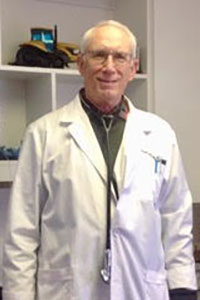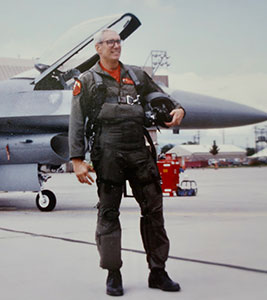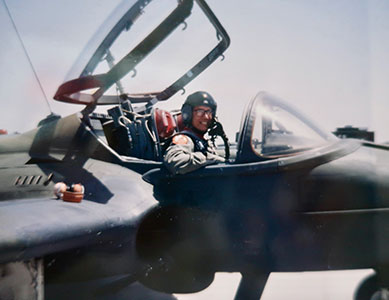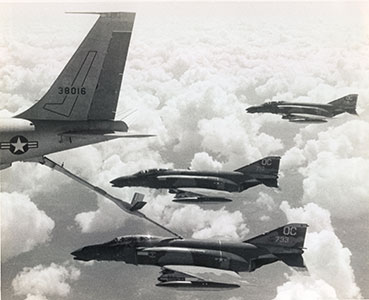Air Force Vietnam War Sycamore, IL Flight date: 10/19/22
By David Adams, Honor Flight Chicago Veteran Interview Volunteer
Imagine you are flying a fighter or a bomber over the skies of Vietnam, Laos, Cambodia, or the Gulf of Tonkin and your jet is thirsty. Paul Stromborg’s KC-135 “Stratotanker” will fill up your fuel tanks. Air Force Captain Stromborg and his tanker crew became adept at keeping combat aircraft in the skies enroute to their targets and for their return to home base after a successful mission, day or night. He also routinely refueled B-52s flying over the States.
Paul was born and grew up on Chicago’s far south side, the eldest of two children, his sister the youngest. He graduated from Morgan Park High School in 1960 and from Northern Illinois University in 1964 with a Bachelor of Science degree and major in biology.
Throughout college he pondered becoming a marine biologist. Following graduation and in the fall of 1964, he obtained a National Science Foundation grant to sail on an ocean research vessel to check out what could be his life’s work. Stanford University operated the 135-foot schooner named Te Vega for use as a “floating classroom” in marine biology and oceanography. He remembers it carried 12,000 feet of sail and accommodated 30 people including the crew. He was one of fifteen academics on board. Among the studies they conducted were investigations of the luminescence of many deep-sea creatures and its role in their lives, of fish migrations, of oceanic food chains, and of the biological economy of the deep-sea environment. To join the Te Vega, he flew to Mombasa, Kenya to begin a 90-day voyage across the Indian Ocean destined for Singapore. It made stops in the Seychelles, Maldives, Ceylon (now Sri Lanka) and finally Singapore. He remembers vividly that before the vessel transited the Straits of Malacca enroute to Singapore, it had to wait for a Navy escort for protection from pirates.
Paul returned home to Illinois after his three-month sea voyage research adventure. Faced with the military draft and carefully considering his options, he selected Air Force Officer Training School, leaving a possible sea-going-career in the Navy behind! He completed the twelve-week OTS course at Lackland AFB, Texas in July 1965, was commissioned a Second Lieutenant, and received an assignment to Undergraduate Pilot Training (UPT) at Moody AFB, Georgia. He and his other OTS and AFROTC officers found stiff competition in the Class of 67-B which he remembers consisted of about one half “Zoomies,” aka USAF Academy graduates. Paul learned to fly the single engine Cessna T-41 Mescalero, twin jet engine Cessna T-37 Tweet, and finally the supersonic Northrop T-38 Talon. The most significant event of UPT training was his first solo flight in the T-38, “a maturing experience.” He persevered through challenging academics, flight simulator training, and over 240 flight hours to earn his wings. Along with wings, he also earned a FAA commercial pilot certificate.
Graduating in September of 1966 and having selected an assignment to fly the KC-135 tanker aircraft, he first attended the three-week Combat Survival Training school at Fairchild AFB, Washington. There he learned techniques in the use of equipment and employment of survival principles and especially how to survive outdoors under any circumstances. Paul remembers distinctly the mountainous terrain, cold weather, and his unsuccessful efforts to evade the “enemy” forces. Next he reported to Castle AFB, California for tanker flight training. The KC-135, developed from the Boeing 707 airliner, had a maximum takeoff gross weight of 322,000 pounds and carried up to 200,000 pounds of fuel for offloading to receiving aircraft. A tanker crew consisted of two pilots, a navigator, and a refueling boom operator, or “boomer” who was enlisted. Paul completed the eleven-week course in December of 1966 as a fully qualified KC-135 pilot.
He received an assignment to the 46th Air Refueling Squadron at K. I. Sawyer AFB in Michigan’s Upper Peninsula. The 46th was a component of the 410th Bombardment Wing, Strategic Air Command (SAC) which flew the B-52. His squadron’s mission was the aerial refueling of B-52 strategic bombers and USAF fighters as necessary from time-to-time. SAC readiness during the Cold War mandated the KC-135s and B-52s pull alert duty 24 hours a day, a week at a time. In 1967, the air war in Vietnam was heating up. Paul recalls that USAF combat operations in the Southeast Asia War were heavily dependent on the support of the KC-135.




Paul and his squadron made three 90-day deployments to Southeast Asia in support of Operation Rolling Thunder over North Vietnam and Operation Barrel Roll in Laos. He deployed once each to U-Tapao AB, Thailand; Kadena AB, Okinawa; and Ching Chuan Kang (CCK) Air Base, Taiwan. In support of combat operations, the 46th refueled B-52s for Operation Arc Light strikes. He recalls refueling sorties for the B-52s, all based in Guam, lasted about eight hours from Kadena and CCK. Fighter refueling sorties from U-Tapao were about four and half hours in length. Fighter strikes of targets in the northern part of North Vietnam such as Hanoi and Haiphong were totally dependent on the tankers.
He remembers that a typical sortie involved a tanker “cell” of three which flew tracks denoted by colors such as brown, green, orange and the like. Refueling tracks were positioned over the Gulf of Tonkin, north of the demilitarized zone (DMZ) during Rolling Thunder (which ended on November 1, 1968) and in northern and eastern Thailand and northern Laos. His tanker routinely accommodated three or four flights of F-4s refueling inbound to targets in North Vietnam and the same number for post-strike fuel on return to base. While the tanker had a reliable autopilot, the pilot always “hand flew” during refueling. Paul recalls that the B-52 was not as agile as the fighters on the boom, but that never posed a problem for the “boomer.” He also remarks that regardless of established limits on how far north their cell could go, tanker crews, his included, often went into North Vietnam and the extreme north of the Gulf to rescue F-105s and F-4s that needed fuel to get home. His tanker also refueled other aircraft including F-105s, EC-135s, and RC-135s.
During the last months of his USAF service, he set his sights on medical school. Having completed most prerequisites for enrollment in medical school during college, he completed the remainder before he left active duty. Paul was honorably discharged on June 16, 1970 having attained the rank of Captain. He received the Air Medal, Vietnam Service Medal and National Defense Service Medal.
Paul began his medical studies almost immediately after his discharge. He attended Chicago Medical School/Rosalind Franklin University of Medicine Science receiving his medical degree in 1974. He is board certified in Internal Medicine. His wife Marilyn, whom he married in 1966, had been an Air Force nurse and worked at Rush Hospital as a Nurse Practitioner during his med school studies. In 1974, he joined a practice in Sycamore where he thrived until his recent retirement.
But wait, there’s more. In 1986, he made another vocational move after the inspirational movie Top Gun was released. He applied to the Peoria’s Illinois Air National Guard’s 169th Tactical Fighter Squadron to serve in the capacity as a flight surgeon. To qualify, he attended what he calls “Knife School” at Wright-Patterson AFB, Ohio. One of his abiding memories from the curriculum was the centrifuge where he experienced up to 9G’s. Quite exhausting.
Flight surgeons have flight time requirements, although at a lower number than pilots. Paul flew in the squadron’s aircraft on nearly a weekly basis. The squadron’s mission was visual reconnaissance serving as forward air controllers (FAC). Flying at a fairly low altitude was required in order to identify ground targets and then marking them for strike aircraft. He flew in the Cessna OA-37A Dragonfly also called the “Super Tweet” the combat version of the T-37 in which he trained during UPT at Moody AFB. In 1992, the OA-37s were retired and the group received the General Dynamics F-16A Fighting Falcon. Paul checked out in the F-16 flying the two-seat B model. Before the 182nd Fighter Group converted to the C-130 Hercules, Paul, now a Lt. Colonel, decided he had had enough multi-engine experience and left the Guard. He logged over 1,500 flight hours combined USAF and Guard.
Paul reports an “interesting follow-up” to his 1964 ocean research voyage on the Te Vega as follows. “My wife was addressing an international cancer conference in Amsterdam and at the same time there was a meeting of tall ships. I wandered the docks looking at these magnificent ships, and there was the Te Vega, now a private yacht (about 22 years later [1987 or 1988]). I introduced myself to the owner who was excited to hear more history of his ship and we were invited back for a cocktail event that night. On the fantail were Russian Naval cadets singing and dancing. I met a man, shook his hand, and struck up a conversation. I asked him if, with perestroika, they saw an increase in Soviet shipping. He quietly stated that he was a Russian merchant captain. He had sailed a sailing vessel with his son from Russia to Amsterdam for the event. I HAD TOUCHED A RUSSIAN!”
Paul retired from the practice of medicine after more than 40 years. He and Marilyn, married 56 years, have two sons and three grandchildren. They have traveled the world, visiting Thailand, Antarctica, Jordan, and Israel among other countries. His hobbies include golf and pickleball. He has been highly active in the Sycamore Rotary Club for over 45 years.
Thank you, Paul, for your dedication and distinguished service during challenging times. Enjoy your well-deserved day of honor in Washington D.C. with your comrades in arms. Expect a splendid welcome home!


